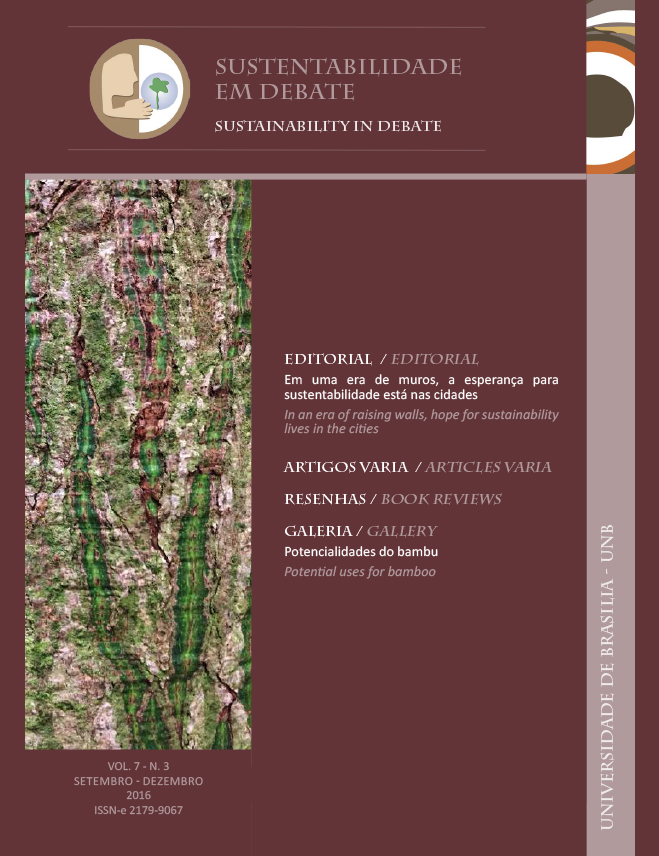Parcerias institucionais e evolução do extrativismo de jaborandi na Floresta Nacional de Carajás, Pará, Brasil
DOI :
https://doi.org/10.18472/SustDeb.v7n3.2016.18955Résumé
Este artigo discute o extrativismo vegetal na região Amazônica a partir da coleta extrativa de folhas de jaborandi, na região de Carajás (Pará, Brasil). Esta planta é utilizada para a extração de pilocarpina que é o insumo para a produção de colírios para tratamento de glaucoma. Buscou-se analisar e teorizar sobre os complexos e múltiplos fatores que determinam a substituição, ou não, da atividade extrativista. A estabilização da demanda nacional e internacional por pilocarpina está permitindo a coexistência do dualismo tecnológico do cultivo da planta e o processo extrativista. Também fica evidente a estratégia por parte de uma das empresas que lideram a extração e exportação de pilocarpina em agregar uma imagem positiva decorrente das parcerias com comunidades extrativistas no Pará e outras regiões de ocorrência natural do jaborandi.
Références
ASSOCIAÇÃO BRASILEIRA DA INDÚSTRIA FARMOQUÍMICA E DE INSUMOS FARMACÊUTICOS ”“ ABIQUIFI. Disponível em: <http://abiquifi.org.br/mercado_/>. Acesso em: 22 abr. 2016.
BERKES, F. The problematique of community-based conservation in a multi-level world. Unpublished mimeo, University of Manitoba, Canada, Natural Resources Institute. 2006. Disponível em: <https://dlc.dlib.indiana.edu/dlc/bitstream/handle/10535/1880/Berkes_fikret_problematique.pdf?sequence=1>. Acesso em: 22 abr. 2016.
BRASIL. Ministério do Desenvolvimento, Indústria e Comércio Exterior ”“ MDIC. Sistema AliceWeb. Disponível em:
<http://aliceweb.desenvolvimento.gov.br/>. Acesso em: 22 abr. 2016.
BRASIL. Ministério do Meio Ambiente. Prêmio Nacional da Biodiversidade 2015. Disponível em: <http://www.mma.gov.br/biodiversidade/premionacionaldabiodiversidade/item/10443>. Acesso em: 22 abr. 2016.
BRITES, A. D.; MORSELLO. C. Efeitos ecológicos da exploração de produtos florestais não madeireiros: uma revisão sistemática. Desenvolv. Meio Ambiente, v. 36, p. 55-72, 2016.
BROWDER, J. O. The limits of extractivism. BioScience, v. 42, n. 3. p. 174-182. 1992.
CENTROFLORA. Grupo Centroflora vence o 1° Prêmio Nacional da Biodiversidade, 22 de maio de 2015. Disponível em: <http://www.centroflora.com.br/grupo-centroflora-vence-o-1-premio-nacional-da-biodiversidade/>. Acesso em: 22 abr. 2016.
CENTROFLORA. Caso de sucesso. Disponível em:
<http://www.centroflora.com.br/caso-de-sucesso/>. Acesso em: 22 abr. 2016.
CONSTANZA, R. et al. The value of the world’s ecosystem services and natural capital. Nature, 387, p. 253-260, 1997.
FREITAS, R. M. et al. Alterações agudas dos níveis de neurotransmissores em corpo estriado de ratos jovens após estado epilético induzido por pilocarpina. Arq. Neuropsiquiatr. v. 61, n. 2-B, p. 430-433, 2003.
GRABHER, C. A governança e a sustentabilidade do extrativismo de jaborandi na Amazônia e transição para o Cerrado e Caatinga. Dissertação (Mestrado) ”“ Universidade Federal do Rio Grande do Sul, Pós-Graduação em Desenvolvimento Rural, Porto Alegre, RS, 2005.
GUERREIRO, G. et al. Atividade antimicrobiana de Pilocarpus riedelianus. In: REUNIÃO ANUAL DA SOCIEDADE BRASILEIRA DE QUÍMICA, 23, 2000, Poços de Caldas, Resumos... Poços de Caldas, 2000. Disponível em: <http://www.sbq.org.br/ranteriores/23/resumos/index.html >. Acesso em: 22 abr. 2016.
GUMIER-COSTA, F. Os folheiros do jaborandi: organização, parcerias e seu lugar no extrativismo amazônico. Tese (Doutorado) ”“ Universidade Federal do Pará, Belém, PA, 2012.
HARDIN, G. The tragedy of the commons. Science, New Series, v. 162, n. 3.859, p. 1243-1248, 1968.
HIREMATH, A. J. The ecological consequences of managing forests for non-timber products. Conservation & Society, v. 2, n. 2, p. 211-216, 2004.
HOLMSTEDT, B. Jaborandi: an interdisciplinary appraisal. Journal of Ethnopharmacology, v. 1, p. 3-21, 1979.
HOMMA, A. K. O. Plant extractivism or plantations: what is the best option for the Amazon? Estudos Avançados, São Paulo, v. 74, n. 26, p. 167-186, 2012.
INSPEÇÕES E CERTIFICAÇÕES AGROPECUÁRIAS E ALIMENTÍCIAS ”“ IBD. Disponível em: <http://ibd.com.br/pt/ ClientesDetalhes.aspx?id_conteudo=29>. Acesso em: 22 abr. 2016.
INSTITUTO BRASILEIRO DE GEOGRAFIA E ESTATÍSTICA ”“ IBGE. Disponível em: <http://www.sidra.ibge.gov.br/bda/ pesquisas/pevs/default.asp>. Acesso em: 22 abr. 2016.
INSTITUTO BRASILEIRO DO MEIO AMBIENTE E DOS RECURSOS NATURAIS RENOVÁVEIS ”“ IBAMA. 2004. Plano de manejo da Floresta Nacional de Carajás. Disponível em: <http://www.icmbio.gov.br>. Acesso em: 22 abr. 2016.
KALIL, A. N.; SPERB, D.; LICHTENFLES, E. Efeito da pilocarpina na regeneração hepática pós-hepatectomia parcial em ratos. Acta. Cir. Bras. v. 13, n. 4, p. 222-226, 1998.
KAOMA, H.; SHACKLETON, C. M. The direct-use value of urban tree non-timber forest products to household income in poorer suburbs in South African towns. Forest Policy and Economics, 61, p. 104-112, 2015.
LEFEVRE, F.; LEFEVRE, A. M. Depoimentos e discursos: uma proposta de análise em pesquisa social. Brasília: Liber Livro Editora, 97p. 2005.
MAFEZOLI, J. et al. In vitro activity of Rutaceae species against the trypomastigote form of Trypanosoma cruzi.
Journal of Ethnopharmacology, v. 73, n. 1, p. 335-340, 2000.
MCGRATH, D. G. et al. Manejo comunitário de lagos de várzeas e o desenvolvimento sustentável da pesca na Amazônia. Novos Cadernos NAEA, v. 1, n. 2, p. 5-32, 1998.
MEDEIROS, R.; YOUNG, C. E. F. C. Contribuição das unidades de conservação brasileiras para a economia nacional: relatório final. Brasília: Unep- WCMC, 120p., 2011.
MENZIES, N. K. Communities and their partners: governance and community-based Forest management.
Conservation & Society, v. 2, n. 2, p. 449-456, 2004.
MERCK. Manejo sustentado do jaborandi nativo no parque ecológico de Carajás. Unidade Agroindustrial da Fazenda Chapada, Barra do Corda, Maranhão, 1997.
MICHI, L. N. Povos indígenas, empresas e os produtos verdes: cenário jurídico da comercialização de produtos florestais não madeireiros. In: IX Congresso internacional e X Congresso brasileiro de direito ambiental, paisagem, natureza e direito, São Paulo, São Paulo, 2005.
MICHI, L. N. O papel do Estado nas parcerias comerciais entre povos indígenas amazônicos e empresas na comercialização de produtos florestais não madeireiros. Dissertação (mestrado) ”“ Programa de Pós-Graduação em Ciência Ambiental, Universidade de São Paulo, SP. 146 fls. 2007.
MORSELLO, C. Market integration and sustainability in Amazonian indigenous livelihoods: the case of the Kayapó. Norwich, Grã-Bretanha, 2002, 301f. Tese (PhD) ”“ School of Environmental Sciences, University of East Anglia, Grã-Bretanha, 2002.
MORSELLO, C. et al. Does trading non-timber forest products drive specialisation in products gathered for consumption? Evidence from the Brazilian Amazon. Ecological Economics, 100, p. 140-149, 2014.
MULENGA, B. P. et al. Rural household participation in markets for non-timber forest products in Zambia.
Environment and Development Economics, v. 19, n. 4, p. 487-504, 2014.
MUÑOZ-NEGRETE, F. J. et al. New Developments in glaucoma medical treatment: nuevos desarrollos en el tratamiento médico del glaucoma. Arch. Soc. Esp. Oftalmol., 84, p. 491-500, 2009.
NORTH, D. The new institutional economics and development. In: American Economic Association meetings, Jan., 1992. Disponível em: <http://www2.econ.iastate.edu/tesfatsi/NewInstE.North.pdf>. Acesso em: 22 abr. 2016.
OSTROM, E. Reformulating the commons. Ambiente & Sociedade, ano V, n. 10, 2002.
OSTROM, E. Understanding institutional diversity. Princeton, New Jersey: Princeton University Press, 355p. 2005.
PEARCE, D. Can non-market values save the world’s forests? In: International symposium on the Non-market benefits of forestry. Edimburg, June, 1996. Forestry Commission, p.1-15, 1996.
PETERS, C. M; GENTRY, A. H.; MENDELSOHN, R. O. Valuation of an Amazonian Rainforest. Nature, 339, p. 655-656, 1989.
PINHEIRO, C. U. B. Extrativismo, cultivo e privatização do jaborandi (Pilocarpus microphyllus Stapf ex Holm. Rutaceae) no Maranhão, Brasil. Acta Bot. Bras., v. 16, n. 2, p. 141-150, 2002.
RIBEIRO, F. A. N. Parcerias comunidade-empresa na Amazônia brasileira. Monografia de conclusão de curso apresentada ao Depto. de Economia da FEA- USP. São Paulo, 2004.
RIZEK, M. B. A comercialização de óleos vegetais na Reserva Extrativista do Médio Rio Juruá, Carauari-AM: de uma estratégia de “desenvolvimento sustentável” Ã mercantilização de comunidades tradicionais extrativistas. Rio Claro, São Paulo, 2006, 65f. Monografia (Conclusão do Curso de Geografia) ”“ Instituto de Geociências e Ciências Exatas, Universidade Estadual Paulista “Júlio de Mesquita Filho”, Campus de Rio Claro, 2006.
ROS-TONEN, M. A. F. et al. Forest-related partnerships in Brazilian Amazonia: there is more to sustainable forest management than reduced impact logging. Forest Ecology and Management, 256, p. 1482-1497, 2008.
RUIZ-PÉREZ, M. Poverty alleviation and forest conservation: the role of non-timber forest products. In: Non- Timber Forest Products between poverty alleviation and market forces. Jean-Laurent Pfund and Patrick Robinson (Ed.), Intercooperation, 2005.
SANTOS, J. G. P. dos. Tutela penal do meio ambiente: o caso dos extrativistas de jaborandi na Floresta de Carajás. Belém: Paka-Tatu, 2003. 94p.
SEGURA, T. et al. Dianas farmacológicas en las enfermedades neurodegenerativas. Rev. Neurol., v. 36, n. 11, p. 1047-1057, 2003.
SILVA, M. F. F.; SECO, R. S.; LOBO, M. G. A. Aspectos ecológicos da vegetação rupestre da serra dos Carajás, estado do Pará, Brasil. Acta Amazonica, 26, p. 17-44, 1996.
SKORUPA, L. A. Espécies de Pilocarpus Vahl (Rutaceae) da Amazônia brasileira. Acta Amazonica, v. 30, n. 1, p. 59-70, 2000.
SOUZA FILHO, J. P. et al. A evolução do mercado farmacêutico brasileiro no tratamento do glaucoma nos últimos 30 anos. Arq. Bras. Oftalmol., v. 66, p. 811-817, 2003.
SOUZA, L. M. Resolução consensual de conflitos coletivos envolvendo políticas públicas. ENAM, Cead/UnB, Brasília, DF. 70p., 2014.
SOUZA, R. C. de. et al. A new imidazole alkaloid and other constituents from Pilocarpus grandiflorus and their antifungal activity. Z. Naturforsch, v. 60b, p. 787-791. 2005.
TICKTIN, T. The ecological implications of harvesting non-timber forest products. Journal of Applied Ecology, 41, p. 11-21, 2004.
TONI, F. Gestão florestal na Amazônia Brasileira: avanços e obstáculos em um sistema federalista. CIFOR & CIID/ IDRC, 73p., 2006.
Téléchargements
Publié
Numéro
Rubrique
Licence
SUSTAINABILITY IN DEBATE – Copyright Statement
The submission of original scientific work(s) by the authors, as the copyright holders of the text(s) sent to the journal, under the terms of Law 9.610/98, implies in the concession of copyrights of printed and/or digital publication to the Sustainability in Debate Journal of the article(s) approved for publication purposes, in a single issue of the journal. Furthermore, approved scientific work(s) will be released without any charge, or any kind of copyright reimbursement, through the journal’s website, for reading, printing and/or downloading of the text file, from the date of acceptance for publication purposes. Therefore, the authors, when submitting the article (s) to the journal, and gratuitous assignment of copyrights related to the submitted scientific work, are fully aware that they will not be remunerated for the publication of the article(s) in the journal.
The Sustainability in Debate Journal is licensed under Creative Commons License – Non-Commercial-No-Derivation Attribution (Derivative Work Ban) 3.0 Brazil, aiming at dissemination of scientific knowledge, as indicated on the journal's website, which allows the text to be shared, and be recognized in regards to its authorship and original publication in this journal.
Authors are allowed to sign additional contracts separately, for non-exclusive distribution of the works published in the Sustainability in Debate Journal (for example, in a book chapter), provided that it is expressed the texts were originally published in this journal. Authors are allowed and encouraged to publish and distribute their text online, following publication in Sustainability in Debate (e.g. in institutional repositories or their personal pages). The authors expressly agree to the terms of this Copyright Statement, which will be applied following the submission and publishing by this journal.









